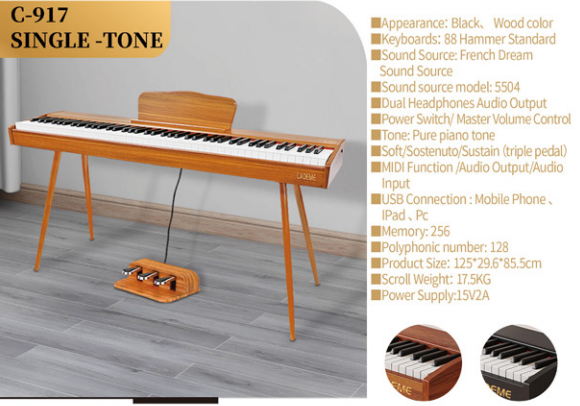Digital pianos have revolutionized the way musicians practice and perform. One of the most significant advantages of digital pianos over traditional acoustic pianos is their ability to control volume. Whether you are a beginner practicing late at night or a professional needing a quiet environment, digital pianos offer the flexibility to adjust sound levels or use headphones for silent practice.
Why Volume Control Matters in Digital Pianos
Volume control in digital pianos is an essential feature for many reasons:
- Allows Silent Practice – With a headphone jack, players can practice without disturbing others.
- Adjustable Sound Levels – Unlike acoustic pianos, digital pianos let users set the volume to a comfortable level.
- Perfect for Shared Spaces – Ideal for apartments, dorms, and homes with thin walls.
- Hearing Protection – Prevents excessive noise levels that may cause hearing fatigue.
Silent Practice with Headphones
One of the most appealing features of digital pianos is the ability to practice in complete silence using headphones. Many digital pianos come equipped with dual headphone jacks, allowing students and teachers to listen simultaneously. The use of headphones enhances concentration by eliminating external noise, making it an excellent tool for focused learning.
Types of Headphone Outputs
- Standard 3.5mm Jack – Compatible with most headphones.
- 6.35mm (1/4 inch) Jack – Found in professional-grade digital pianos.
- Wireless Bluetooth Connectivity – Some modern digital pianos support wireless headphones for a tangle-free experience.
Choosing the Best Digital Piano with Volume Control
When selecting a digital piano with effective volume control, consider the following factors:
1. Built-in Speakers and Volume Adjustment
A good digital piano should have high-quality built-in speakers with adjustable volume. Entry-level models may have smaller speakers, while professional models feature multi-speaker systems for a richer sound experience.
2. Headphone Compatibility and Sound Quality
The quality of sound through headphones is crucial for an immersive experience. Look for a digital piano with high-fidelity sound processing and multiple headphone output options.
3. Touch Sensitivity and Dynamic Control
Even with volume control, a digital piano should replicate the dynamics of an acoustic piano. Touch-sensitive keys allow for soft and loud playing, enhancing musical expression.
4. Pedal Compatibility and Sustain Adjustments
For a realistic playing experience, choose a digital piano that supports sustain pedals and allows volume adjustments even with pedal effects enabled.
Advantages of Digital Pianos Over Acoustic Pianos
1. Noise-Free Practice Anytime
Unlike acoustic pianos, which produce sound through physical hammer and string action, digital pianos use sampled or modeled sounds, allowing for silent practice with headphones.
2. Portability and Space-Saving Design
Digital pianos are often lighter and more compact than traditional pianos, making them perfect for small apartments and music studios.
3. Customizable Sound and Volume Settings
Players can adjust tone settings, reverb, and volume, which is impossible with an acoustic piano.
4. Additional Features for Versatility
Many digital pianos offer recording functions, Bluetooth connectivity, and various instrument sounds, making them versatile for different playing styles.
How to Get the Best Sound from a Digital Piano with Volume Control
To ensure optimal sound quality, follow these tips:
- Use High-Quality Headphones – Invest in studio-grade headphones for clear and accurate sound.
- Adjust Volume Gradually – Avoid sudden changes in volume to protect hearing.
- Optimize Speaker Positioning – If using external speakers, place them at ear level for the best sound projection.
- Experiment with EQ Settings – Many digital pianos allow you to adjust bass, treble, and midrange frequencies.
A digital piano with volume control and headphone support is an excellent investment for musicians who need flexibility in their practice routine. Whether you are playing in a quiet environment, practicing late at night, or sharing a space with others, these pianos provide an ideal solution. When selecting a model, prioritize sound quality, touch sensitivity, and headphone compatibility to enhance your playing experience.





